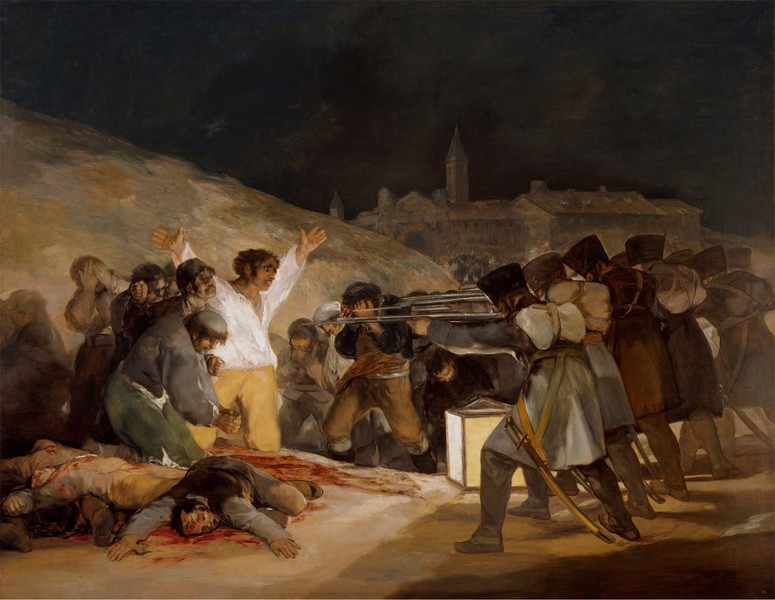- Cronología
- 1814
- Ubicación
- The Prado National Museum. Madrid, Madrid, Spain
- Dimensiones
- 268 x 347 cm
- Técnica y soporte
- Oil on canvas
- Reconocimiento de la autoría de Goya
- Documented work
- Titular
- El Prado National Museum
- Ficha: realización/revisión
- 17 Mar 2010 / 28 Aug 2024
- Inventario
- (P00749)
- Otros títulos:
-
The Executions of the Third of May (Los fusilamientos del tres de mayo)
The Executions of mountain Principe Pío (Los fusilamientos en la montaña del príncipe Pío)
See Second of May 1808.
The executions of the insurgents depicted in this work's companion painting took place during the night following the attacks on the French troops. As Murat said to the chaplain Francisco Gállego Dávila, also an insurgent, "he who lives by the sword dies by the sword", and this is how the first episode of the War of Independence played out.
The focus of attention in the composition is the condemned men who await their imminent death. At their feet are the bodies of those who have already been killed, portrayed with startling, realist brutality. On the right we can see the row of infantry of the line soldiers who point their bayonets at the men. They are portrayed as faceless: it does not matter who kills who - it is all irrational violence. The fundamental element of this painting is the different poses which Goya has given to each of the men who confront their destiny. Fear consumes them all, but we can also detect rage in the figure with the clenched fists, anguish in the man in the white shirt with the open arms, desperation for clemency in the figure who crosses his arms, or the regret of the figure who holds his hands up to his mouth in the group of figures approaching behind the rifles.
The background of this scene is the city, outlined against the sky which is in mourning, weighing down on the figures. The light coming from the lantern, which is cast in a cube-shaped pattern (and on many occasions has been referred to as a precursor to the cubism movement), accentuates the cruelty of the scene, highlighting the blood which bathes the floor of this place somewhere in the outskirts of Madrid. It has been suggested that the location might be the so-called mountain of Príncipe Pío, but some documents from the time show that there was no door like that depicted by Goya here. It has also been posited that this might be Puerta de la Vega, where executions also took place. Nevertheless, as in the case of its companion painting, identifying the setting is not important; what matters is the tragedy seen through the eyes of those who will die before the implacable French machine.
Has been recently restored. On the lower left-hand corner there are remains of the damages happened during its moving to Valencia in 1937, because of the Spanish civil war.
-
Goya. 250 AniversarioMuseo Nacional del PradoMadrid1996consultant editor Juan J. Luna. From March 29th to June 2nd 1996cat. 142
-
Goya en tiempos de guerraMuseo Nacional del PradoMadrid2008consultant editor Manuela B. Mena Marqués, from April 14th to July 13th 2008cat. 124
-
Goya: Order and disorderMuseum of Fine ArtsBoston2014cat. 7
-
L'œuvre peint de Goya. 4 volsParís1928-1950p. 254, cat. 226
-
Vie et ouvre de Francisco de GoyaParísOffice du livre1970pp. 207, 257, 267, cat. 984
-
BarcelonaPolígrafa1970vol. I, p. 360, cat. 624
-
L’opera pittorica completa di GoyaMilanRizzoli1974p. 128, cat. 566
-
Francisco de Goya, 4 vols.ZaragozaCaja de Ahorros de Zaragoza, Aragón y Rioja1980-1982vol. IV, p. 22 y pp. 129, 136-137
-
Goya. 250 AniversarioMadridMuseo del Prado1996p. 411, cat. 142 y pp. 242-243 (ils.)
-
Goya en tiempos de guerraMadridMuseo Nacional del Prado2008p. 353, cat. 124 y pp. 355, 360, 362, 36
-
Goya: Order & DisorderBostonMuseum of Fine Arts Boston Publications2014pp. 28-29

